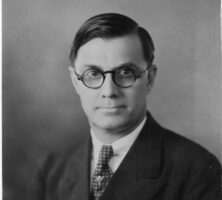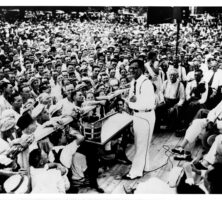A controversial and colorful politician, Eugene Talmadge played a leading role in the state’s politics from 1926 to 1946. During his three terms as state commissioner of agriculture and three terms as governor, his personality and actions polarized voters into Talmadge and anti-Talmadge factions in the state’s one-party politics of that era. He was elected to a fourth term as the state’s chief executive in 1946 but died before taking office.
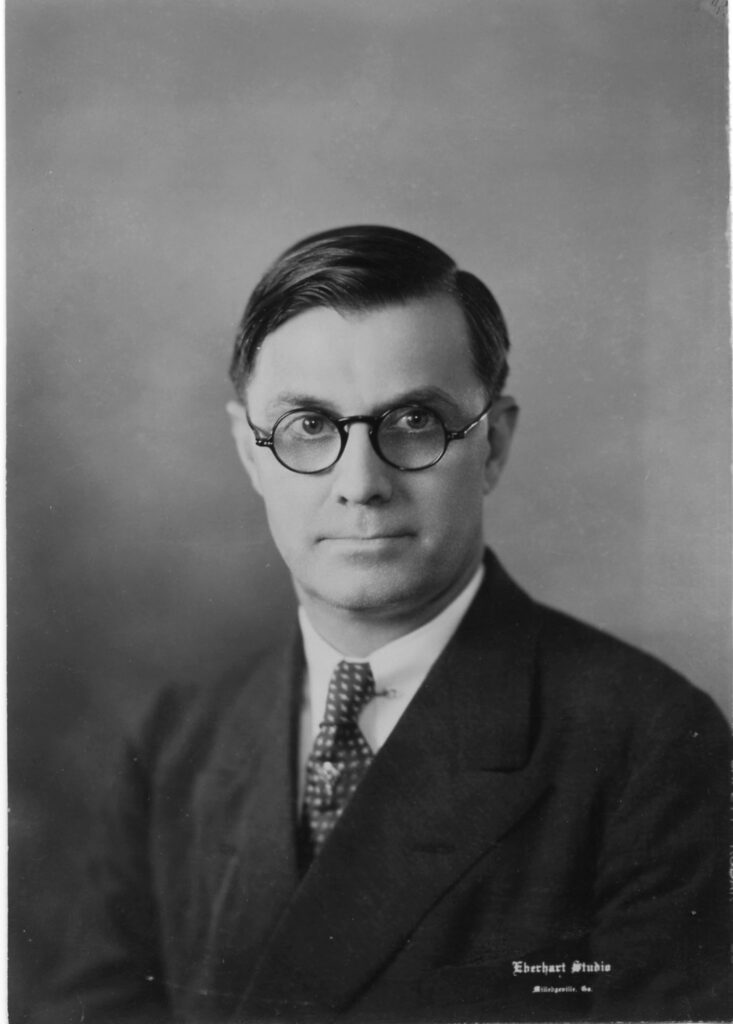
Courtesy of Hargrett Rare Book and Manuscript Library, University of Georgia Libraries.
Family and Education
Eugene Talmadge was born on the family farm near Forsyth on September 23, 1884, to Carrie Roberts and Thomas R. Talmadge. After attending the University of Georgia and briefly teaching, Talmadge returned to Athens to earn a law degree (1907). He practiced law briefly in Atlanta before moving to Ailey and then Mt. Vernon to start his own practice. In 1909 he married Mattie Thurmond Peterson, a young widow, who was the telegraph operator in Ailey. They had three children: Margaret, Vera, and Herman Eugene. The Talmadges later moved to a farm in Telfair County.
Early Political Career
After holding minor offices in Telfair County, Talmadge made unsuccessful runs for state legislative office in 1920 and 1922. He finally won state elective office by defeating Commissioner of Agriculture J. J. Brown in 1926. Talmadge was overwhelmingly reelected in 1928 and 1930. He used the department’s newspaper, the Market Bulletin, to give advice to farmers on how to improve their farming skills and operations. But more important, Talmadge used the Bulletin to express his views on political issues and to present himself as an outspoken advocate for the farmers. He extolled the virtues of a laissez-faire economic policy and individual action to improve the well-being of farmers.
His critics in the legislature attempted to rein in the freewheeling and outspoken Talmadge. The senate adopted a committee report charging the commissioner with violating a state law requiring that fertilizer fees collected by the department be deposited in the state treasury. The committee also concluded that Talmadge had improperly spent department funds on a scheme to raise the price of hogs. The senate committee further criticized the commissioner for having paid himself and family members more than $40,000 in salaries and expenses and for using department funds to underwrite his annual trips to the Kentucky Derby. A committee of the Georgia house recommended that Governor Richard B. Russell Jr. sue Talmadge to recover state funds spent on the hog-buying scheme. A minority report even called for his impeachment. The house agreed to sue but rejected the call to initiate impeachment proceedings against the commissioner. Russell referred the issue to the state attorney general, who declined to bring suit.
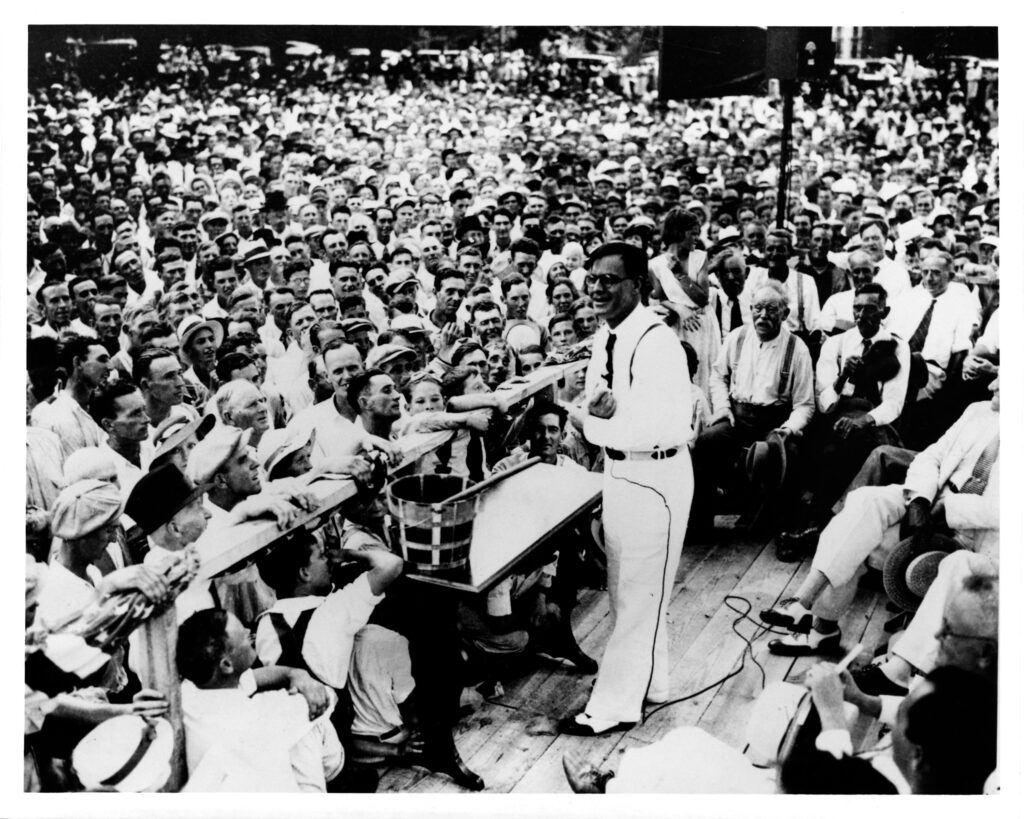
Courtesy of Hargrett Rare Book and Manuscript Library, University of Georgia Libraries.
Governorship
Still popular with his rural constituency, Talmadge considered running for higher political office in 1932. Governor Russell ran for a seat in the U.S. Senate instead of seeking reelection. Talmadge entered the Democratic Party’s crowded gubernatorial primary and won without a runoff. He promised to run the government economically, balance the state budget, lower utility rates, reduce the price of automobile tags to three dollars, and reorganize the state highway board.
In the 1934 Democratic gubernatorial primary, Talmadge easily won reelection, carrying every county but three. In his first two gubernatorial terms Talmadge proved to be a strong governor. When the legislature refused to lower the price of automobile tags, he did so by executive order. When the Public Service Commission, a body elected by the voters, refused to lower utility rates, he appointed a new board to get it done. When the highway board resisted his efforts to control it, he declared martial law and appointed more cooperative members to the board. When the state treasurer and comptroller general refused to cooperate, the governor had them physically removed from their offices in the state capitol. Critics denounced him as a dictator, a demagogue, and a threat to the tranquillity of the state, but his supporters considered him a friend of the common man and one of the state’s outstanding governors.

Courtesy of Atlanta History Center.
Talmadge, a leading critic of the New Deal in the South, opposed the renomination of U.S. president Franklin D. Roosevelt in 1936. Barred by the state constitution from running again after two successive two-year terms, Talmadge unsuccessfully ran for the U.S. Senate against the incumbent Richard Russell in 1936. Two years later, his efforts to replace Senator Walter F. George also ended in failure. He finally returned to elective office with his successful gubernatorial bid in 1940.
During his third term Governor Talmadge forced the University System Board of Regents to remove two faculty members, claiming that they were undermining the state’s racial status quo, in what became known as the Cocking affair. In response to this political interference, the Southern Association of Colleges and Schools voted to withdraw accreditation from the state’s white colleges. Promising to restore accreditation, state attorney general Ellis Arnall ran against Talmadge in the 1942 gubernatorial primary and handed him the only loss Talmadge suffered in a gubernatorial contest.
Final Election
Although Arnall had a productive and progressive governorship, the state constitution, which had been changed to lengthen the gubernatorial term from two to four years, prohibited a successive term. Talmadge decided to run again. The federal courts’ invalidation of the Democratic Party’s white primary before the 1946 primaries gave Talmadge an important issue. While Arnall supported the federal courts’ decisions, Talmadge, denouncing the courts’ actions as a threat to segregation, promised to restore the white primary and to maintain the state’s commitment to white supremacy. At that time, statewide elections in Georgia were governed by a county unit system of votes, which greatly favored candidates whose support came from rural counties. Under this system counties cast two, four, or six votes, depending on their classification as rural, town, or urban areas, respectively. Although the anti-Talmadge candidate James V. Carmichael received the most popular votes in the primary, Talmadge, who had very strong support in rural areas, won the gubernatorial nomination by obtaining a majority of the county unit votes.
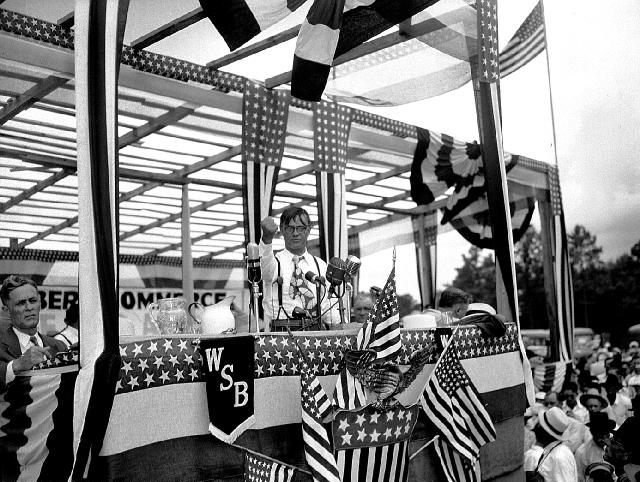
Courtesy of Special Collections & Archives, Georgia State University Library.
Governor-elect Eugene Talmadge died on December 21, 1946, before taking office. His death resulted in one of the oddest political battles in Georgia’s history, known as the “three governors controversy.” In January 1947 the General Assembly finally elected Eugene Talmadge’s son, Herman Talmadge, governor, although he had not run for office. He served until the state supreme court overturned his legislative election in March.
Perhaps Herman Talmadge best described how Georgians felt about his father when he said that a third of the people would follow his father to hell and a third of them wanted him in hell. Eugene Talmadge’s belief in negative government and his bitter opposition to the New Deal and racial equality did little to improve the material well-being of Georgians during his governorship.









